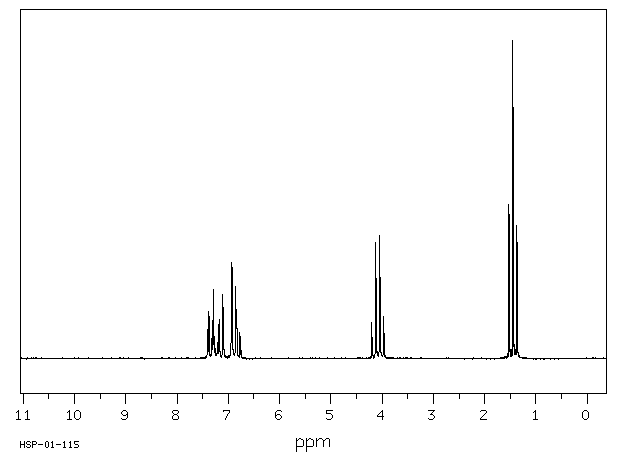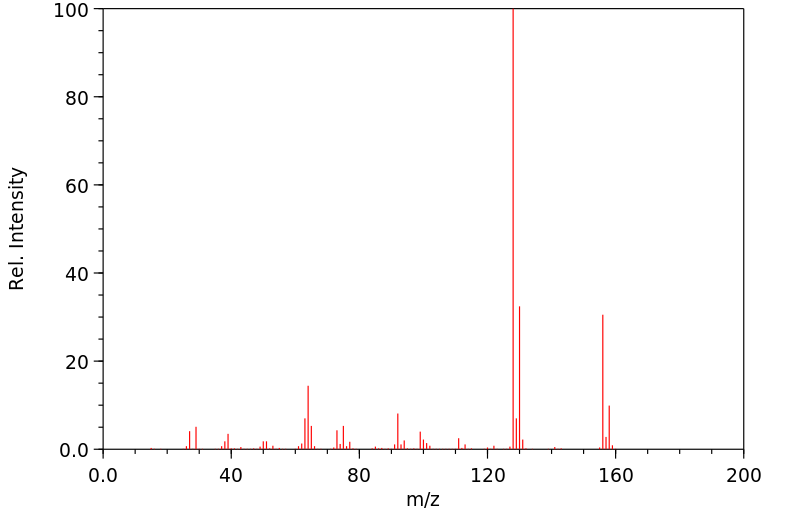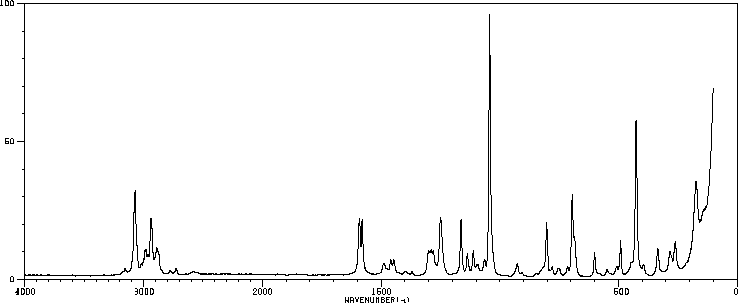鄰氯苯基乙基醚 | 614-72-2
物质功能分类
中文名称
鄰氯苯基乙基醚
中文别名
邻氯苯乙醚;邻氯苯基乙基醚;邻氯乙氧基苯;2-氯苯乙醚
英文名称
1-chloro-2-ethoxybenzene
英文别名
o-chloroethoxybenzene;2-ethoxychlorobenzene;benzene, 1-chloro-2-ethoxy-;2-chlorophenetole;o-chlorophenetole;Aethyl-(2-chlor-phenyl)-aether;2-Chlor-1-aethoxy-benzol;monochlorophenetole;2-Chlor-phenetol;o-Chlor-phenetol;chloro-2-ethoxybenzene
CAS
614-72-2
化学式
C8H9ClO
mdl
MFCD00058930
分子量
156.612
InChiKey
IRYSAAMKXPLGAM-UHFFFAOYSA-N
BEILSTEIN
——
EINECS
——
-
物化性质
-
计算性质
-
ADMET
-
安全信息
-
SDS
-
制备方法与用途
-
上下游信息
-
文献信息
-
表征谱图
-
同类化合物
-
相关功能分类
-
相关结构分类
物化性质
-
熔点:190-191.5 °C
-
沸点:210 °C
-
密度:1,14 g/cm3
-
稳定性/保质期:
性质与稳定性:在常温常压下,不会分解产生任何产物。
计算性质
-
辛醇/水分配系数(LogP):3
-
重原子数:10
-
可旋转键数:2
-
环数:1.0
-
sp3杂化的碳原子比例:0.25
-
拓扑面积:9.2
-
氢给体数:0
-
氢受体数:1
安全信息
-
危险类别码:R36/37/38
-
海关编码:2909309090
-
安全说明:S26,S36/37/39
-
储存条件:贮存: 将密器密封后,放入密封的主藏器中,并置于阴凉、干燥处。
SDS
2-Chlorophenetole Revision number: 1
SAFETY DATA SHEET
Section 1. BASE INFORMATION
Product name: 2-Chlorophenetole
Revision number: 1
Section 2. HAZARDS IDENTIFICATION
Classification of the GHS
PHYSICAL HAZARDS
Flammable liquids Category 4
Not classified
HEALTH HAZARDS
ENVIRONMENTAL HAZARDS Not classified
GHS label elements
Pictograms or hazard symbols None
Warning
Signal word
Hazard statement Combustible liquid
Precautionary statements
[Prevention] Keep away from flames and hot surfaces.
Wear protective gloves and eye/face protection.
[Storage] Store in a well-ventilated place. Keep cool.
Dispose of contents/container through a waste management company authorized by
[Disposal]
the local government
Section 3. COMPOSITION/INFORMATION ON INGREDIENTS
Substance/mixture: Substance
Component(s): 2-Chlorophenetole
Percent: >99.0%(GC)
614-72-2
CAS Number:
Synonyms: 1-Chloro-2-ethoxybenzene
Chemical Formula: C8H9ClO
Section 4. FIRST AID MEASURES
Inhalation: Remove victim to fresh air and keep at rest in a position comfortable for breathing.
Get medical advice/attention if you feel unwell.
Skin contact: Remove/Take off immediately all contaminated clothing. Rinse skin with
water/shower. If skin irritation or rash occurs: Get medical advice/attention.
Rinse cautiously with water for several minutes. Remove contact lenses, if present
Eye contact:
and easy to do. Continue rinsing. If eye irritation persists: Get medical
advice/attention.
Ingestion: Get medical advice/attention if you feel unwell. Rinse mouth.
Protection of first-aiders: A rescuer should wear personal protective equipment, such as rubber gloves and air-
tight goggles.
2-Chlorophenetole
Section 5. FIRE-FIGHTING MEASURES
Suitable extinguishing Dry chemical, foam, water spray, carbon dioxide.
media:
Extinguishing media not to Solid streams of water
be used:
Specific hazards: Take care as it may decompose upon combustion or in high temperatures to
generate poisonous fume.
Specific methods: Fire-extinguishing work is done from the windward and the suitable fire-extinguishing
method according to the surrounding situation is used. Uninvolved persons should
evacuate to a safe place. In case of fire in the surroundings: Remove movable
containers if safe to do so.
Special protective When extinguishing fire, be sure to wear personal protective equipment.
equipment for firefighters:
Section 6. ACCIDENTAL RELEASE MEASURES
Use personal protective equipment. Keep people away from and upwind of spill/leak.
Personal precautions,
protective equipment and Ensure adequate ventilation. Entry to non-involved personnel should be controlled
emergency procedures: around the leakage area by roping off, etc.
Environmental precautions: Prevent product from entering drains.
Methods and materials for Absorb spilled material in a suitable absorbent (e.g. rag, dry sand, earth, saw-dust).
containment and cleaning In case of large amount of spillage, contain a spill by bunding. Adhered or collected
up: material should be promptly disposed of, in accordance with appropriate laws and
regulations.
Prevention of secondary Remove all sources of ignition. Fire-extinguishing devices should be prepared in
hazards: case of a fire. Use spark-proof tools and explosion-proof equipment.
Section 7. HANDLING AND STORAGE
Handling
Technical measures: Handling is performed in a well ventilated place. Wear suitable protective equipment.
Prevent generation of vapor or mist. Keep away from flames and hot surfaces. Take
measures to prevent the build up of electrostatic charge. Use explosion-proof
equipment. Wash hands and face thoroughly after handling.
Use a closed system, ventilation.
Advice on safe handling: Avoid contact with skin, eyes and clothing.
Storage
Storage conditions: Keep container tightly closed. Store in a cool, dark and well-ventilated place.
Store away from incompatible materials such as oxidizing agents.
Packaging material: Law is followed.
Section 8. EXPOSURE CONTROLS / PERSONAL PROTECTION
Install a closed system or local exhaust as possible so that workers should not be
Engineering controls:
exposed directly. Also install safety shower and eye bath.
Personal protective equipment
Respiratory protection: Vapor respirator. Follow local and national regulations.
Hand protection: Protective gloves.
Eye protection: Safety glasses. A face-shield, if the situation requires.
Skin and body protection: Protective clothing. Protective boots, if the situation requires.
Section 9. PHYSICAL AND CHEMICAL PROPERTIES
Physical state (20°C): Liquid
Form: clear
Color: Colorless - Slightly pale yellow
Odor: No data available
pH: No data available
Melting point/freezing point:No data available
210 °C
Boiling Point/Range:
Flash Point: No data available
2-Chlorophenetole
Section 9. PHYSICAL AND CHEMICAL PROPERTIES
Explosive limits
No data available
Lower:
Upper: No data available
1.14
Density:
Solubility: No data available
Section 10. STABILITY AND REACTIVITY
Stability: Stable under proper conditions.
Reactivity: No special reactivity has been reported.
Incompartible materials: oxidizing agents
Hazardous Decomposition Carbon monoxide, Carbon dioxide, Hydrogen chloride
Products:
Section 11. TOXICOLOGICAL INFORMATION
No data available
Acute Toxicity:
Skin corrosion/irritation: No data available
No data available
Serious eye
damage/irritation:
Germ cell mutagenicity: No data available
Carcinogenicity:
No data available
IARC =
NTP = No data available
No data available
Reproductive toxicity:
Section 12. ECOLOGICAL INFORMATION
Ecotoxicity:
Fish: No data available
Crustacea: No data available
Algae: No data available
Persistence / degradability: No data available
Bioaccumulative No data available
potential(BCF):
Mobillity in soil
log Pow: No data available
Soil adsorption (Koc): No data available
Henry's Law No data available
constant(PaM3/mol):
Section 13. DISPOSAL CONSIDERATIONS
Recycle to process, if possible. Consult your local regional authorities. You may be able to burn in a chemical
incinerator equipped with an afterburner and scrubber system. Observe all federal, state and local regulations when
disposing of the substance.
Section 14. TRANSPORT INFORMATION
Hazards Class: Does not correspond to the classification standard of the United Nations
UN-No: Not Listed
Section 15. REGULATORY INFORMATION
Safe management ordinance of dangerous chemical product (State Council announces on January 26,
2002): Safe use and production, the storage of a dangerous chemical, transport, loading and unloading were
prescribed.
2-Chlorophenetole
SECTION 16 - ADDITIONAL INFORMATION
N/A
SAFETY DATA SHEET
Section 1. BASE INFORMATION
Product name: 2-Chlorophenetole
Revision number: 1
Section 2. HAZARDS IDENTIFICATION
Classification of the GHS
PHYSICAL HAZARDS
Flammable liquids Category 4
Not classified
HEALTH HAZARDS
ENVIRONMENTAL HAZARDS Not classified
GHS label elements
Pictograms or hazard symbols None
Warning
Signal word
Hazard statement Combustible liquid
Precautionary statements
[Prevention] Keep away from flames and hot surfaces.
Wear protective gloves and eye/face protection.
[Storage] Store in a well-ventilated place. Keep cool.
Dispose of contents/container through a waste management company authorized by
[Disposal]
the local government
Section 3. COMPOSITION/INFORMATION ON INGREDIENTS
Substance/mixture: Substance
Component(s): 2-Chlorophenetole
Percent: >99.0%(GC)
614-72-2
CAS Number:
Synonyms: 1-Chloro-2-ethoxybenzene
Chemical Formula: C8H9ClO
Section 4. FIRST AID MEASURES
Inhalation: Remove victim to fresh air and keep at rest in a position comfortable for breathing.
Get medical advice/attention if you feel unwell.
Skin contact: Remove/Take off immediately all contaminated clothing. Rinse skin with
water/shower. If skin irritation or rash occurs: Get medical advice/attention.
Rinse cautiously with water for several minutes. Remove contact lenses, if present
Eye contact:
and easy to do. Continue rinsing. If eye irritation persists: Get medical
advice/attention.
Ingestion: Get medical advice/attention if you feel unwell. Rinse mouth.
Protection of first-aiders: A rescuer should wear personal protective equipment, such as rubber gloves and air-
tight goggles.
2-Chlorophenetole
Section 5. FIRE-FIGHTING MEASURES
Suitable extinguishing Dry chemical, foam, water spray, carbon dioxide.
media:
Extinguishing media not to Solid streams of water
be used:
Specific hazards: Take care as it may decompose upon combustion or in high temperatures to
generate poisonous fume.
Specific methods: Fire-extinguishing work is done from the windward and the suitable fire-extinguishing
method according to the surrounding situation is used. Uninvolved persons should
evacuate to a safe place. In case of fire in the surroundings: Remove movable
containers if safe to do so.
Special protective When extinguishing fire, be sure to wear personal protective equipment.
equipment for firefighters:
Section 6. ACCIDENTAL RELEASE MEASURES
Use personal protective equipment. Keep people away from and upwind of spill/leak.
Personal precautions,
protective equipment and Ensure adequate ventilation. Entry to non-involved personnel should be controlled
emergency procedures: around the leakage area by roping off, etc.
Environmental precautions: Prevent product from entering drains.
Methods and materials for Absorb spilled material in a suitable absorbent (e.g. rag, dry sand, earth, saw-dust).
containment and cleaning In case of large amount of spillage, contain a spill by bunding. Adhered or collected
up: material should be promptly disposed of, in accordance with appropriate laws and
regulations.
Prevention of secondary Remove all sources of ignition. Fire-extinguishing devices should be prepared in
hazards: case of a fire. Use spark-proof tools and explosion-proof equipment.
Section 7. HANDLING AND STORAGE
Handling
Technical measures: Handling is performed in a well ventilated place. Wear suitable protective equipment.
Prevent generation of vapor or mist. Keep away from flames and hot surfaces. Take
measures to prevent the build up of electrostatic charge. Use explosion-proof
equipment. Wash hands and face thoroughly after handling.
Use a closed system, ventilation.
Advice on safe handling: Avoid contact with skin, eyes and clothing.
Storage
Storage conditions: Keep container tightly closed. Store in a cool, dark and well-ventilated place.
Store away from incompatible materials such as oxidizing agents.
Packaging material: Law is followed.
Section 8. EXPOSURE CONTROLS / PERSONAL PROTECTION
Install a closed system or local exhaust as possible so that workers should not be
Engineering controls:
exposed directly. Also install safety shower and eye bath.
Personal protective equipment
Respiratory protection: Vapor respirator. Follow local and national regulations.
Hand protection: Protective gloves.
Eye protection: Safety glasses. A face-shield, if the situation requires.
Skin and body protection: Protective clothing. Protective boots, if the situation requires.
Section 9. PHYSICAL AND CHEMICAL PROPERTIES
Physical state (20°C): Liquid
Form: clear
Color: Colorless - Slightly pale yellow
Odor: No data available
pH: No data available
Melting point/freezing point:No data available
210 °C
Boiling Point/Range:
Flash Point: No data available
2-Chlorophenetole
Section 9. PHYSICAL AND CHEMICAL PROPERTIES
Explosive limits
No data available
Lower:
Upper: No data available
1.14
Density:
Solubility: No data available
Section 10. STABILITY AND REACTIVITY
Stability: Stable under proper conditions.
Reactivity: No special reactivity has been reported.
Incompartible materials: oxidizing agents
Hazardous Decomposition Carbon monoxide, Carbon dioxide, Hydrogen chloride
Products:
Section 11. TOXICOLOGICAL INFORMATION
No data available
Acute Toxicity:
Skin corrosion/irritation: No data available
No data available
Serious eye
damage/irritation:
Germ cell mutagenicity: No data available
Carcinogenicity:
No data available
IARC =
NTP = No data available
No data available
Reproductive toxicity:
Section 12. ECOLOGICAL INFORMATION
Ecotoxicity:
Fish: No data available
Crustacea: No data available
Algae: No data available
Persistence / degradability: No data available
Bioaccumulative No data available
potential(BCF):
Mobillity in soil
log Pow: No data available
Soil adsorption (Koc): No data available
Henry's Law No data available
constant(PaM3/mol):
Section 13. DISPOSAL CONSIDERATIONS
Recycle to process, if possible. Consult your local regional authorities. You may be able to burn in a chemical
incinerator equipped with an afterburner and scrubber system. Observe all federal, state and local regulations when
disposing of the substance.
Section 14. TRANSPORT INFORMATION
Hazards Class: Does not correspond to the classification standard of the United Nations
UN-No: Not Listed
Section 15. REGULATORY INFORMATION
Safe management ordinance of dangerous chemical product (State Council announces on January 26,
2002): Safe use and production, the storage of a dangerous chemical, transport, loading and unloading were
prescribed.
2-Chlorophenetole
SECTION 16 - ADDITIONAL INFORMATION
N/A
上下游信息
反应信息
-
作为反应物:描述:参考文献:名称:Cu 2 O催化芳烷基醚的高效脱烷基摘要:已经描述了在廉价且易于重复使用的Cu 2 O催化下使芳基烷基醚脱烷基的有效方案。以高收率获得苯酚产物,并且对一系列官能团的耐受性良好。溶剂的选择对催化至关重要,事实证明,CH 3 OH是最佳选择。机理研究表明,该反应可能通过单电子转移(SET)过程进行。DOI:10.1016/j.tet.2018.03.070
-
作为产物:参考文献:名称:Swarts, Journal de Chimie Physique et de Physico-Chimie Biologique, 1923, vol. 20, p. 60摘要:DOI:
文献信息
-
Process facilitating the regeneration of a catalyst based on a zeolite used in an acylation reaction, catalyst and use申请人:——公开号:US20020120169A1公开(公告)日:2002-08-29The present invention relates to a process facilitating the regeneration of a catalyst based on a zeolite, employed in an acylation reaction. Another subject of the invention is a process for acylation of an aromatic ether, comprising, in a preferred alternative form, an additional stage of regeneration of the catalyst. The process of the invention, which makes it possible to regenerate more easily a catalyst based on a zeolite, employed in an acylation reaction, is characterized in that the zeolite is modified by addition of an effective quantity of at least one metallic element M chosen from the elements of group 8 of the Periodic Classification of the elements.
-
[EN] TRICYCLIC INHIBITORS OF INFLUENZA VIRUS ENDONUCLEASE<br/>[FR] INHIBITEURS TRICYCLIQUES DE L'ENDONUCLÉASE DU VIRUS DE LA GRIPPE申请人:WEBB THOMAS R公开号:WO2021195278A1公开(公告)日:2021-09-30The present disclosure is concerned with 9-hydroxy-6-(pyrrolidin-2-yl)-3,4-dihydro-2H-pyrazino[ 1,2-c]pyrimidine- 1, 8-dione compounds for the treatment of various viral infections such as, for example, influenza virus. This abstract is intended as a scanning tool for purposes of searching in the particular art and is not intended to be limiting of the present invention.
-
NAPHTHYRIDINONE ANALOGS AS MGLUR5 POSITIVE ALLOSTERIC MODULATORS申请人:Conn P. Jeffrey公开号:US20120172391A1公开(公告)日:2012-07-05In one aspect, the invention relates to naphthyridinone analogs, derivatives thereof, and related compounds, which are useful as positive allosteric modulators of the metabotropic glutamate receptor subtype 5 (mGluR5); synthetic methods for making the compounds; pharmaceutical compositions comprising the compounds; and methods of treating neurological and psychiatric disorders associated with glutamate dysfunction using the compounds and compositions. This abstract is intended as a scanning tool for purposes of searching in the particular art and is not intended to be limiting of the present invention.
-
Composition and compound based on salt (s) of metals and of acid exhibiting a sulfonyl group carried by a perhalogenated carbon and their use as lewis acid申请人:——公开号:US20040116733A1公开(公告)日:2004-06-17The present invention relates to a bismuth-type promoter and its use as a Lewis acid catalyst for acylation reactions of aromatic compounds. The promoter corresponds to the formula MY &mgr;−q &xgr; q , where M represents a &mgr;-valent and at least trivalent element in the cationic form, preferably known to give Lewis acids, where Y is a monovalent anion or a monovalent anionic functional group, where &xgr; − represents an anion or an anionic functional group carrying a sulfonyl functional group carried by a perhalogenated atom, preferably a perfluorinated atom, more preferably a perfluoromethylene (—CF 2 —); and where q is an integer advantageously chosen within the closed range (comprising the limits) ranging from 1 to (&mgr;−1) (that is to say, 1 or 2 when &mgr; is 3). The present application also relates to processes for the preparation of the promoter.
-
Facile Synthesis of Chloro-substituted Aromatic Ethers by Use of Benzyltrimethylammonium Tetrachloroiodate作者:Shoji Kajigaeshi、Youichi Shinmasu、Shizuo Fujisaki、Takaaki KakinamiDOI:10.1246/cl.1989.415日期:1989.3The reaction of aromatic ethers with a calculated amount of benzyltrimethylammonium tetrachloroiodate in acetic acid (or dichloromethane) under mild conditions gave, selectively, the objective chloro-substituted aromatic ethers in good yields.
表征谱图
-
氢谱1HNMR
-
质谱MS
-
碳谱13CNMR
-
红外IR
-
拉曼Raman
-
峰位数据
-
峰位匹配
-
表征信息
同类化合物
(R)-3-(叔丁基)-4-(2,6-二异丙氧基苯基)-2,3-二氢苯并[d][1,3]氧杂磷杂环戊烯
(2S,3R)-3-(叔丁基)-2-(二叔丁基膦基)-4-甲氧基-2,3-二氢苯并[d][1,3]氧杂磷杂戊环
(2S,2''S,3S,3''S)-3,3''-二叔丁基-4,4''-二甲氧基-2,2'',3,3''-四氢-2,2''-联苯并[d][1,3]氧杂磷杂戊环
(2R,2''R,3R,3''R)-3,3''-二叔丁基-4,4''-二甲氧基-2,2'',3,3''-四氢-2,2''-联苯并[d][1,3]氧杂磷杂戊环
(2-氟-3-异丙氧基苯基)三氟硼酸钾
(+)-6,6'-{[(1R,3R)-1,3-二甲基-1,3基]双(氧)}双[4,8-双(叔丁基)-2,10-二甲氧基-丙二醇
麦角甾烷-6-酮,2,3,22,23-四羟基-,(2a,3a,5a,22S,23S)-
鲁前列醇
顺式6-(对甲氧基苯基)-5-己烯酸
顺式-铂戊脒碘化物
顺式-四氢-2-苯氧基-N,N,N-三甲基-2H-吡喃-3-铵碘化物
顺式-4-甲氧基苯基1-丙烯基醚
顺式-2,4,5-三甲氧基-1-丙烯基苯
顺式-1,3-二甲基-4-苯基-2-氮杂环丁酮
非那西丁杂质7
非那西丁杂质3
非那西丁杂质22
非那西丁杂质18
非那卡因
非布司他杂质37
非布司他杂质30
非布丙醇
雷诺嗪
阿达洛尔
阿达洛尔
阿莫噁酮
阿莫兰特
阿维西利
阿索卡诺
阿米维林
阿立酮
阿曲汀中间体3
阿普洛尔
阿普斯特杂质67
阿普斯特中间体
阿普斯特中间体
阿托西汀EP杂质A
阿托莫西汀杂质24
阿托莫西汀杂质10
阿托莫西汀EP杂质C
阿尼扎芬
阿利克仑中间体3
间苯胺氢氟乙酰氯
间苯二酚二缩水甘油醚
间苯二酚二异丙醇醚
间苯二酚二(2-羟乙基)醚
间苄氧基苯乙醇
间甲苯氧基乙酸肼
间甲苯氧基乙腈
间甲苯异氰酸酯











